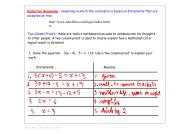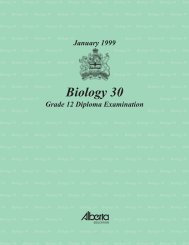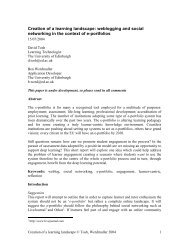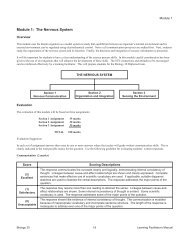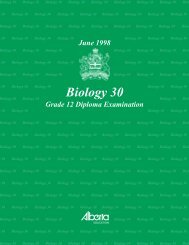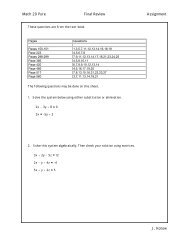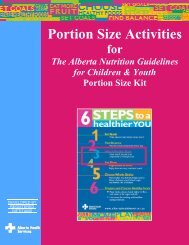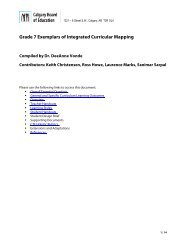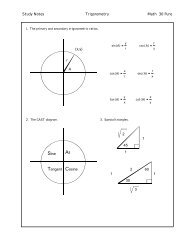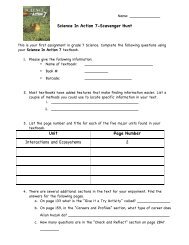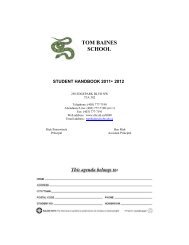Biology 30 January 1998 Grade 12 Diploma Examination
Biology 30 January 1998 Grade 12 Diploma Examination
Biology 30 January 1998 Grade 12 Diploma Examination
Create successful ePaper yourself
Turn your PDF publications into a flip-book with our unique Google optimized e-Paper software.
iology <strong>30</strong> <strong>Biology</strong> <strong>30</strong> <strong>Biology</strong> <strong>30</strong> <strong>Biology</strong> <strong>30</strong> <strong>Biology</strong> <strong>30</strong> <strong>Biology</strong> <strong>30</strong> <strong>Biology</strong> <strong>30</strong> <strong>Biology</strong> <strong>30</strong> Bioloiology <strong>30</strong> <strong>Biology</strong> <strong>30</strong> <strong>Biology</strong> <strong>30</strong> <strong>Biology</strong> <strong>30</strong> <strong>Biology</strong> <strong>30</strong> <strong>Biology</strong> <strong>30</strong> <strong>Biology</strong> <strong>30</strong> <strong>Biology</strong> <strong>30</strong> Biolo<strong>30</strong> <strong>Biology</strong> <strong>30</strong> <strong>Biology</strong> <strong>30</strong> <strong>Biology</strong> <strong>30</strong> <strong>Biology</strong> <strong>30</strong> <strong>Biology</strong> <strong>30</strong> <strong>Biology</strong> <strong>30</strong> <strong>Biology</strong> <strong>30</strong> <strong>Biology</strong> <strong>30</strong>iology <strong>30</strong> <strong>Biology</strong> <strong>30</strong> <strong>Biology</strong> <strong>30</strong> <strong>Biology</strong> <strong>30</strong> <strong>Biology</strong> <strong>30</strong> <strong>Biology</strong> <strong>30</strong> <strong>Biology</strong> <strong>30</strong> <strong>Biology</strong> <strong>30</strong> Biolo<strong>30</strong> <strong>Biology</strong> <strong>30</strong> <strong>Biology</strong> <strong>30</strong> <strong>Biology</strong> <strong>30</strong> <strong>Biology</strong> <strong>30</strong> <strong>Biology</strong> <strong>30</strong> <strong>Biology</strong> <strong>30</strong> <strong>Biology</strong> <strong>30</strong> <strong>Biology</strong> <strong>30</strong><strong>January</strong> <strong>1998</strong>iology <strong>30</strong> <strong>Biology</strong> <strong>30</strong> <strong>Biology</strong> <strong>30</strong> <strong>Biology</strong> <strong>30</strong> <strong>Biology</strong> <strong>30</strong> <strong>Biology</strong> <strong>30</strong> <strong>Biology</strong> <strong>30</strong> <strong>Biology</strong> <strong>30</strong> Biolo<strong>30</strong> <strong>Biology</strong> <strong>30</strong> <strong>Biology</strong> <strong>30</strong> <strong>Biology</strong> <strong>30</strong> <strong>Biology</strong> <strong>30</strong> <strong>Biology</strong> <strong>30</strong> <strong>Biology</strong> <strong>30</strong> <strong>Biology</strong> <strong>30</strong> <strong>Biology</strong> <strong>30</strong>iology <strong>30</strong> <strong>Biology</strong> <strong>30</strong> <strong>Biology</strong> <strong>30</strong> <strong>Biology</strong> <strong>30</strong> <strong>Biology</strong> <strong>30</strong> <strong>Biology</strong> <strong>30</strong> <strong>Biology</strong> <strong>30</strong> <strong>Biology</strong> <strong>30</strong> Biolo<strong>30</strong> <strong>Biology</strong> <strong>30</strong> <strong>Biology</strong> <strong>30</strong> <strong>Biology</strong> <strong>30</strong> <strong>Biology</strong> <strong>30</strong> <strong>Biology</strong> <strong>30</strong> <strong>Biology</strong> <strong>30</strong> <strong>Biology</strong> <strong>30</strong> <strong>Biology</strong> <strong>30</strong><strong>Biology</strong> <strong>30</strong>iology <strong>30</strong> <strong>Biology</strong> <strong>30</strong> <strong>Biology</strong> <strong>30</strong> <strong>Biology</strong> <strong>30</strong> <strong>Biology</strong> <strong>30</strong> <strong>Biology</strong> <strong>30</strong> <strong>Biology</strong> <strong>30</strong> <strong>Biology</strong> <strong>30</strong> Biolo<strong>Grade</strong> <strong>12</strong> <strong>Diploma</strong> <strong>Examination</strong><strong>30</strong> <strong>Biology</strong> <strong>30</strong> <strong>Biology</strong> <strong>30</strong> <strong>Biology</strong> <strong>30</strong> <strong>Biology</strong> <strong>30</strong> <strong>Biology</strong> <strong>30</strong> <strong>Biology</strong> <strong>30</strong> <strong>Biology</strong> <strong>30</strong> <strong>Biology</strong> <strong>30</strong>iology <strong>30</strong> <strong>Biology</strong> <strong>30</strong> <strong>Biology</strong> <strong>30</strong> <strong>Biology</strong> <strong>30</strong> <strong>Biology</strong> <strong>30</strong> <strong>Biology</strong> <strong>30</strong> <strong>Biology</strong> <strong>30</strong> <strong>Biology</strong> <strong>30</strong> Biolo<strong>30</strong> <strong>Biology</strong> <strong>30</strong> <strong>Biology</strong> <strong>30</strong> <strong>Biology</strong> <strong>30</strong> <strong>Biology</strong> <strong>30</strong> <strong>Biology</strong> <strong>30</strong> <strong>Biology</strong> <strong>30</strong> <strong>Biology</strong> <strong>30</strong> <strong>Biology</strong> <strong>30</strong>iology <strong>30</strong> <strong>Biology</strong> <strong>30</strong> <strong>Biology</strong> <strong>30</strong> <strong>Biology</strong> <strong>30</strong> <strong>Biology</strong> <strong>30</strong> <strong>Biology</strong> <strong>30</strong> <strong>Biology</strong> <strong>30</strong> <strong>Biology</strong> <strong>30</strong> Biolo<strong>30</strong> <strong>Biology</strong> <strong>30</strong> <strong>Biology</strong> <strong>30</strong> <strong>Biology</strong> <strong>30</strong> <strong>Biology</strong> <strong>30</strong> <strong>Biology</strong> <strong>30</strong> <strong>Biology</strong> <strong>30</strong> <strong>Biology</strong> <strong>30</strong> <strong>Biology</strong> <strong>30</strong>iology <strong>30</strong> <strong>Biology</strong> <strong>30</strong> <strong>Biology</strong> <strong>30</strong> <strong>Biology</strong> <strong>30</strong> <strong>Biology</strong> <strong>30</strong> <strong>Biology</strong> <strong>30</strong> <strong>Biology</strong> <strong>30</strong> <strong>Biology</strong> <strong>30</strong> Biolo<strong>30</strong> <strong>Biology</strong> <strong>30</strong> <strong>Biology</strong> <strong>30</strong> <strong>Biology</strong> <strong>30</strong> <strong>Biology</strong> <strong>30</strong> <strong>Biology</strong> <strong>30</strong> <strong>Biology</strong> <strong>30</strong> <strong>Biology</strong> <strong>30</strong> <strong>Biology</strong> <strong>30</strong>iology <strong>30</strong> <strong>Biology</strong> <strong>30</strong> <strong>Biology</strong> <strong>30</strong> <strong>Biology</strong> <strong>30</strong> <strong>Biology</strong> <strong>30</strong> <strong>Biology</strong> <strong>30</strong> <strong>Biology</strong> <strong>30</strong> <strong>Biology</strong> <strong>30</strong> Biolo<strong>30</strong> <strong>Biology</strong> <strong>30</strong> <strong>Biology</strong> <strong>30</strong> <strong>Biology</strong> <strong>30</strong> <strong>Biology</strong> <strong>30</strong> <strong>Biology</strong> <strong>30</strong> <strong>Biology</strong> <strong>30</strong> <strong>Biology</strong> <strong>30</strong> <strong>Biology</strong> <strong>30</strong>iology <strong>30</strong> <strong>Biology</strong> <strong>30</strong> <strong>Biology</strong> <strong>30</strong> <strong>Biology</strong> <strong>30</strong> <strong>Biology</strong> <strong>30</strong> <strong>Biology</strong> <strong>30</strong> <strong>Biology</strong> <strong>30</strong> <strong>Biology</strong> <strong>30</strong> Bioloi<strong>30</strong> <strong>Biology</strong> <strong>30</strong> <strong>Biology</strong> <strong>30</strong> <strong>Biology</strong> <strong>30</strong> <strong>Biology</strong> <strong>30</strong> <strong>Biology</strong> <strong>30</strong> <strong>Biology</strong> <strong>30</strong> <strong>Biology</strong> <strong>30</strong> <strong>Biology</strong> <strong>30</strong>
Copyright <strong>1998</strong>, the Crown in Right of Alberta, as represented by the Minister of Education, AlbertaEducation, Student Evaluation Branch, 11160 Jasper Avenue, Edmonton, Alberta T5K 0L2. All rightsreserved. Additional copies may be purchased from the Learning Resources Distributing Centre.Special permission is granted to Alberta educators only to reproduce, for educational purposes and ona non-profit basis, parts of this examination that do not contain excerpted material only after theadministration of this examination.Excerpted material in this examination shall not be reproduced without the written permission of theoriginal publisher (see credits page, where applicable).
<strong>January</strong> <strong>1998</strong><strong>Biology</strong> <strong>30</strong><strong>Grade</strong> <strong>12</strong> <strong>Diploma</strong> <strong>Examination</strong>DescriptionTime: 2.5 h. You may take anadditional 0.5 h to complete theexamination.This is a closed-book examinationconsisting of• 48 multiple-choice and 8 numericalresponsequestions, of equal value,worth 70% of the examination• 2 written-response questions, of equalvalue, worth <strong>30</strong>% of the examination• 80 total possible marks, worth 100% ofthe examinationThis examination contains setsof related questions.A set of questions may containmultiple-choice and/or numericalresponseand/or written-responsequestions.Tear-out data pages are included nearthe back of this booklet.The blank perforated pages at the backof this booklet may be torn out and usedfor your rough work. No marks will begiven for work done on the tear-outpages.Instructions• Fill in the information required on theanswer sheet and the examinationbooklet as directed by the presidingexaminer.• You are expected to provide your ownscientific calculator.• Use only an HB pencil for themachine-scored answer sheet.• If you wish to change an answer, eraseall traces of your first answer.• Consider all numbers used in theexamination to be the result of ameasurement or observation.• Do not fold the answer sheet.• The presiding examiner will collectyour answer sheet and examinationbooklet and send them to AlbertaEducation.• Now turn this page and read thedetailed instructions for answeringmachine-scored and written-responsequestions.
Multiple Choice• Decide which of the choices bestcompletes the statement or answersthe question.• Locate that question number on theseparate answer sheet provided andfill in the circle that corresponds toyour choice.ExampleThis examination is for thesubject ofA. biologyB. physicsC. chemistryD. scienceAnswer SheetA B C DNumerical Response• Record your answer on the answersheet provided by writing it in theboxes and then filling in thecorresponding circles.• If an answer is a value between 0 and 1(e.g., 0.25), then be sure to record the 0before the decimal place.• Enter the first digit of your answerin the left-hand box and leave anyunused boxes blank.ExamplesCalculation Question and SolutionThe average of the values 21.0, 25.5, and 24.5is _________.(Round and record your answer to threesignificant digits in the numerical-responsesection of the answer sheet.)Average = (21.0 + 25.5 + 24.5)/3= 23.666= 23.7Record 23.7 on theanswer sheet 2 3 . 7. .0 0 0 01 1 1 <strong>12</strong> 2 2 23 3 3 34 4 4 45 5 5 56 6 6 67 7 7 78 8 8 89 9 9 9ii
Written ResponseCorrect-Order Question and SolutionWhen the following subjects are arranged inalphabetical order, the order is ______.(Record all four digits in the numerical-responsesection of the answer sheet.)1 physics2 chemistry3 biology4 scienceAnswer 3214Record 3214 on theanswer sheet 3 2 1 4. .0 0 0 01 1 1 <strong>12</strong> 2 2 23 3 3 34 4 4 45 5 5 56 6 6 67 7 7 78 8 8 89 9 9 9• Write your answers in the examinationbooklet as neatly as possible.• For full marks, your answers must bewell organized and address all the mainpoints of the question.• Relevant scientific, technological, and/orsocietal concepts and examples must beidentified and explicit.• Descriptions and/or explanations ofconcepts must be correct and reflectpertinent ideas, calculations, andformulas.• Your answers should be presented in awell-organized manner using completesentences, correct units, and significantdigits where appropriate.Selection Question and SolutionThe birds in the following list are numbered______.(Record your answer in lowest-to-highest numericalorder in the numerical-response section of theanswer sheet.)1 dog2 sparrow3 cat4 robin5 chickenAnswer 245Record 245 on theanswer sheet 245. .0 0 0 01 1 1 <strong>12</strong> 2 2 23 3 3 34 4 4 45 5 5 56 6 6 67 7 7 78 8 8 89 9 9 9iii
While animals interact with their external environment, their nervous and endocrinesystems maintain internal equilibrium. The study of organisms and of disease processeshas helped extend our knowledge of these systems.Use the following information to answer the next two questions.“The [study of the squid, led] to an understanding of the nature of the nerve impulse.[Its] . . . nerves contain the giant axons used in all the early studies of the nerve impulse.”An Action Potential—from Curtis and Barnes+40Membrane potential(millivolts)+200–20–40–60–80XThreshold potentialTime (milliseconds)Note: X denotes the electrical potential across the membrane of a particular resting neuron.1. Which of the following statements is true of the threshold potential?A. It is the same electrical potential for all neurons.B. It is the depolarization required to generate an action potential.C. It determines the time it takes for an action potential to be completed.D. It determines the time it takes for an impulse to travel along the axon.2. Relative to inside of a neuron, the extracellular fluid immediately outside a restingneuron’s cell membrane isA. positive and the sodium ion concentration is lessB. negative and the sodium ion concentration is lessC. positive and the sodium ion concentration is greaterD. negative and the sodium ion concentration is greater1
Use the following information to answer the next two questions.Processes That Occur at a Neuromuscular Junction(A Type of Synapse)1 Muscle fibres contract when sodium gates open allowing sodium ions to diffuse into themuscle cytoplasm.2 Acetylcholine is released from the axon terminal.3 Acetylcholine binds to the receptors on the muscle cell.4 Cholinesterase breaks down acetylcholine, and the sodium gates close.—from GuytonNumerical Response01. An impulse arrives at an axon terminal that synapses with a muscle cell. Recordthe processes in the order that they occur at the synapse.(Record your four-digit answer in the numerical-response section of the answer sheet.)Answer: __________3. Certain chemicals inhibit cholinesterase at neuromuscular junctions. The resultingmuscular spasms occur because of theA. depletion of cholinesterase in the presynaptic neuronB. depletion of acetylcholine in the neuromuscular junctionC. accumulation of cholinesterase in the presynaptic neuronD. accumulation of acetylcholine in the neuromuscular junctionUse the following information to answer the next question.Twenty-two once-paralyzed rats can now move their hind legs and even take awkward steps.Their damaged spinal cords have been partially repaired by surgically grafting nerve fibresfrom another part of their bodies to the damaged area.—from Flam4. The division of the nervous system that was damaged in these rats is theA. central nervous systemB. somatic nervous systemC. sympathetic nervous systemD. parasympathetic nervous system2
Use the following information to answer the next three questions.NeuronsX Y ZNeuron INeuron IIINeuron II5. Neurotransmitters are released fromA. site XB. site ZC. sites X and YD. sites X and Z6. If neurons I and II are interneurons, neuron III cannot be aA. parasympathetic neuronB. sympathetic neuronC. sensory neuronD. motor neuron7. In a typical reflex arc, neuron III would be part of theA. effectorB. receptorC. motor pathwayD. sensory pathway3
8. When adaptation of the eye occurs to view objects in a dark room,A. the pupil increases in size and the rods become activeB. the pupil decreases in size and the rods become activeC. the pupil increases in size and the cones become activeD. the pupil decreases in size and the cones become activeUse the following information to answer the next question.Sensory hair cells in the inner ear can be damaged by excessive noise or certain drugs. Thismay cause deafness or balance disorders. Research suggests that these cells have the ability toregenerate. In one study, the damaged inner ear tissue of guinea pigs was cultured in a dish.The damaged tissue produced new sensory hair cells.from Gutin9. Which parts of the ear contain these sensory hair cells?A. Auditory nerve and cochleaB. Eardrum and auditory nerveC. Eustachian tube and eardrumD. Cochlea and semicircular canals__________________________Use the following information to answer the next question.Control of the Secretion of Hormone Y by the Pituitary GlandPituitary gland(−)Negative feedbackHormone X Endocrine gland Hormone YOthermetabolic effects10. Normally, inhibition of the pituitary gland would occur if the secretion ofhormone XA. increased, causing a decrease in the secretion of hormone YB. decreased, causing a decrease in the secretion of hormone YC. increased, causing an increase in the secretion of hormone YD. decreased, causing an increase in the secretion of hormone Y4
Use the following information to answer the next two questions.Stressful situations trigger the release of hormones such as cortisol. Recent studies have foundthat some forms of depression cause a similar hormonal response that lasts much longer thanthe normal stress response. This unregulated release of stress hormones may result in reducedappetite, an unresponsive immune system, inadequate tissue repair, and insomnia.11. Another stress hormone whose functions mimic those of the sympathetic nervoussystem isA. HCGB. insulinC. estrogenD. norepinephrineUse the following additional information to answer the next question.A dog with a malfunctioning pituitary gland received injections of ACTH. Data werecollected after the dog’s injections.Rate of Cortisol Secretion After the Injectionof Varying Amounts of ACTH6 Amount of ACTH injectedCortisol secretion rate(units/min)5432100 4 8 <strong>12</strong> 16 20 24 28 32 36Time after injection of ACTH (min)2 units5 units10 units50 units—from Ganong<strong>12</strong>. A logical interpretation of the graph is that theA. secretion of cortisol is inhibited by increased ACTHB. secretion of cortisol is doubled if the secretion of ACTH is doubledC. adrenal glands respond more quickly to small amounts of ACTH than to largeamounts of ACTHD. adrenal glands respond to large amounts of ACTH by having a maximumcortisol secretion rate5
Use the following information to answer the next question.In 1947, E. B. Verney published the results of a series of experiments that he had conductedon a number of dogs. He found that if he injected a concentrated salt solution into thebloodstream, hypothalamus, and ventricles of the brain, hormone “X” was released in largeamounts.13. Hormone “X” was most likelyA. ADHB. ACTHC. oxytocinD. aldosterone__________________________14. The endocrine function of the pancreas was studied in Canada using dogs asexperimental animals. The pancreatic cells with an endocrine function areA. islet cellsB. blood cellsC. Sertoli cellsD. interstitial cellsUse the following information to answer the next two questions.Bovine somatotropin (BST) is a growth hormone that has been produced using biotechnologysince 1970. BST increases milk production by 10% to 20% when injected into milkproducingcows. BST increases nutrient absorption from the bloodstream into the cow’smammary gland.–from Harpp and Joseph15. BST could probably be obtained naturally from which gland in a cow?A. ThyroidB. AdrenalC. PituitaryD. Pancreatic6
16. In a cow’s mammary gland, BST is most similar in its effect toA. estrogenB. oxytocinC. prolactinD. progesterone__________________________17. In humans, when iodine levels are adequate, abnormally high TSH secretion wouldlikely result inA. nervousness and weight gainB. nervousness and weight lossC. sleepiness and weight gainD. sleepiness and weight lossUse the following information to answer the next question.Several studies have indicated that sperm counts in humans have declined over the past 25years. Increased levels of chemicals in the environment that mimic estrogen have been foundin substances ranging from detergents to plastic wrappers. These chemicals are a suspectedcause of the decline in sperm counts.—from Stainsby18. Males exposed to high levels of these estrogen-mimicking chemicals couldexperienceA. development of breastsB. development of ovariesC. increased growth of musclesD. increased growth of facial hair7
Reproductive processes may be affected by disease, the environment, or the use oftechnology.Use the following information to answer the next question.Male Reproductive System<strong>12</strong>3419. The structure that may function both as a site for spermatogenesis and as anendocrine gland is labelledA. 1B. 2C. 3D. 4__________________________Use the following information to answer the next question.An unusual and rare form of the disease cystic fibrosis results in the absence of the vas deferensin males.—from Henahan20. When this occurs, infertility results because ofA. decreased spermatogenesisB. an inability to maintain an erectionC. decreased secretions of alkaline buffersD. the failure of sperm to reach the urethra8
Use the following information to answer the next two questions.Composite Diagram of a Human Ovary,,,,1 2 3 4This diagram shows the sequence of events in the development of a follicle in onereproductive cycle of a non-pregnant female.21. The part of the diagram that represents the follicle just before day 14 of an averageovarian cycle is labelledA. 1B. 2C. 3D. 422. Which description identifies the chromosome content of cell 4?A. n = 23B. n = 46C. 2n = 23D. 2n = 469
Use the following information to answer the next question.Microscopic examination has revealed protective layers surrounding the oocyte. The firstsperm to reach the oocyte is usually not the one to fertilize it.23. The reason this first sperm may not fertilize the oocyte is thatA. its nucleus may not be acceptable for fertilizationB. some sperm produce enzymes that fail to break down the protective layersC. the enzymes from many sperm are needed to penetrate the protective layersD. the protective layers secrete chemicals that destroy many sperm that contact theoocyte__________________________24. A graph that illustrates the cyclical variation in progesterone levels in onereproductive cycle of a non-pregnant human female isA. B.Progesteronelevel0 28DaysProgesteronelevel0 28DaysC. D.Progesteronelevel0 28DaysProgesteronelevel0 28Days25. It has been observed that some breastfeeding mothers do not ovulate until they stopbreast feeding. Ovulation would not occur ifA. prolactin inhibits the release of oxytocinB. prolactin inhibits follicular developmentC. oxytocin stimulates the release of FSH and LHD. oxytocin stimulates the release of gonadotropin-releasing hormone10
Use the following information to answer the next question.A Schematic View of the PlacentaUmbilical arteriesUmbilical veinUmbilical cordPlacental capillariesPlacental villiUterine veinUterine arterioles—from Curtis26. Which of the following does not normally occur at the placenta?A. Nutrients move from the maternal blood to the fetal bloodB. Blood cells move from the maternal blood to the fetal bloodC. Carbon dioxide moves from the fetal blood to the maternal bloodD. Metabolic wastes move from the fetal blood to the maternal blood11
Use the following information to answer the next two questions.Development of external genital structures of both sexes from the sameundifferentiated embryonic structuresUndifferentiated stage at 7 weeksClitorisLabia minoraLabia majoraFemale developmentMale development—from Campbell27. Study the diagram. In the table below, the row that identifies two pairs of male andfemale external genital structures where each pair develops from the sameembryonic structure isCome from Same Embryonic Structure Come from Same Embryonic StructureMale Female Male FemaleA. penis–shaft clitoris scrotum vaginaB. penis–shaft labia majora scrotum labia minoraC. penis–glans clitoris scrotum labia majoraD. penis–glans labia majora scrotum labia minora<strong>12</strong>
28. Under normal circumstances, what initially determines whether an embryodevelops into a male or a female?A. The embryo develops testes for a male and ovaries for a female.B. The embryo predominantly produces testosterone for a male and estrogenfor a female.C. The embryo’s genital embryonic structures develop into those of a male orthose of a female.D. The embryo develops into a male if fertilization involved a Y-carrying spermand into a female if fertilization involved an X-carrying sperm.Use the following information to answer the next question.Some Structures of the Human Female<strong>12</strong>329. The gland that releases oxytocin and the target organ for oxytocin are labelled,respectively,A. 1 and 2B. 1 and 3C. 2 and 1D. 2 and 313
The study of cell division, chromosome composition, and the structure and function ofDNA increases understanding of growth, heredity, and diversity of organisms.Use the following information to answer the next three questions.Males and females of different lizard species can interbreed, but often the offspring of thesematings are sterile. However, some of the female offspring, as adults, produce diploid eggsthat develop without fertilization. The offspring of these “virgin births” all reproduce in thesame way as their mother.Species 1 (2n)ASpecies 2 (2n)AGeneration ISperm (1n)BEgg (1n)Female offspringCGeneration IIEgg (2n)DOffspringGeneration III—from Richardson<strong>30</strong>. Phenotypically, generation III offspring will beA. female, and each individual will be genotypically differentB. female, and each individual will be genotypically identicalC. 50% male and 50% female, and will be genotypically differentD. 50% male and 50% female, and will be genotypically identical31. If a new disease-causing organism from which lizards have no protection reachesan island where a uniform population of lizards reproduce only asexually, a likelyoutcome is thatA. rapid extinction of the lizard population will occurB. the lizard population will begin to reproduce sexuallyC. gene frequencies will change in the lizard population’s gene poolD. unique individuals in the lizard population will not find a mating partner14
Numerical Response02. From the list below, identify the processes that correspond to A, B, C, and D in thediagram on the previous page.Normal Processes1 Fertilization2 Meiosis3 Mitosis(Record your four-digit answer in the numerical-response section of the answer sheet.)Answer: Process _____ _____ _____ _____A B C D__________________________Use the following information to answer the next question.Many adult newts and salamanders have a remarkable ability to regenerate amputated limbs.After amputation of a foot, a newt will regenerate the lost foot. However, if a newt has its footamputated and receives a particular dosage of vitamin A, the animal grows back a whole newforelimb, not just the foot!—from Pietsch32. A logical interpretation that can be drawn from this information is that vitamin Amay play a major role in growth byA. increasing the amount of mitosisB. increasing the amount of meiosisC. decreasing the amount of mitosisD. decreasing the amount of meiosis15
Use the following information to answer the next three questions.Nondisjunction in meiosis disrupts the chromosome number in the gametes that are produced.Nondisjunction can occur in either the first or second division of meiosis and results in variousgenetic disorders.33. One homologous pair of chromosomes in a human spermatogonium undergoesnondisjunction during the first division of meiosis. After meiosis is completed,what number of chromosomes will the four newly produced cells contain?A. All four cells will have 23 chromosomes.B. Two cells will have 22 chromosomes, and two cells will have 24 chromosomes.C. One cell will have 22 chromosomes, and three cells will have 24 chromosomes.D. One cell will have 24 chromosomes, and three cells will have 22 chromosomes.34. Which expression of chromosome content represents somatic cells in people withtrisomy disorders such as Down syndrome?A. n – 1B. n + 1C. 2n – 1D. 2n + 1Use the following additional information to answer the next question.Polyploids are organisms with three or more complete sets of chromosomes. If a diploidorganism is 2n, then a triploid is 3n, a tetraploid is 4n, and so on.All major groups of seed plants have some polyploid members. Plant polyploids are largerthan plants with 2n chromosome number. Plant polyploids with even chromosome numbers(e.g., 4n) can usually produce pollen and seeds. Plant polyploids with odd chromosomenumbers (e.g., 5n) are nearly always sterile.35. If a diploid plant and a tetraploid plant, each capable of normal meiosis, werecrossed, the chromosome number in their offspring would beA. 2nB. 3nC. 4nD. 6n16
Use the following information to answer the next question.A Cellular Structure Found During Mitosis36. This diagram of a cellular structure showsA. one crossed-over pair of chromosomesB. two homologous chromosomesC. one tetrad of chromatidsD. two sister chromatids__________________________Use the following information to answer the next question.The San Diego Zoo is preserving DNA from hundreds of species by freezing cell samples inits Centre for the Reproduction of Endangered Species. The cell specimens are often fromindividuals in wild populations that are chosen for distinctive characteristics.—from Vedantam37. To obtain all the representative DNA of an organism, it would be necessary to collect onlyA. an eggB. a spermC. a body cellD. a cell from each type of body tissueNumerical Response03. Of the nitrogen-based molecules present in the DNA of sea urchins, 17.5% are cytosinemolecules. Calculate the percentage composition of thymine in sea urchin DNA.(Record your answer as a percentage rounded to one decimal place in the numerical-responsesection of the answer sheet.)Answer: ________%17
Use the following information to answer the next three questions.Gregor Mendel examined the inheritance of two traits in pea plants: seed coat texture andcolour. Seed coat texture can be represented as S–smooth and s–wrinkled, and seed coatcolour can be represented as Y–yellow and y–green. SSYY plants were crossed with ssyyplants to yield F 1 pea seeds that were all smooth and all yellow. By crossing plants grownfrom these F 1 seeds, Mendel obtained four different phenotypes of F 2 seeds:• smooth and green seeds• wrinkled and green seeds• smooth and yellow seeds• wrinkled and yellow seeds38. If the traits for seed coat texture and seed coat colour had been located closetogether on the same chromosome, Mendel might not have conceptualizedA. gene pairsB. dominanceC. the Law of SegregationD. the Law of Independent AssortmentNumerical Response04. The F 2 seed phenotype ratio that Mendel obtained upon crossing two heterozygoussmooth and yellow F 1 individuals would have been __________.(Record your four-digit answer in the numerical-response section of the answer sheet.)Answer: ___________ : ___________ : __________ : ___________smooth and wrinkled and smooth and wrinkled andgreen green yellow yellow18
Use the following additional information to answer the next question.Mendel selected two varieties of pea plants from seeds he had grown. One variety of peascame from a field planted with smooth, yellow seeds. Another variety of peas came from afield planted with wrinkled, green seeds. These two varieties of peas were crossed to produce255 plants with smooth and green seeds268 plants with wrinkled and green seeds237 plants with smooth and yellow seeds240 plants with wrinkled and yellow seedsFrom the phenotype ratio of the offspring, Mendel deduced that the smooth and yellow parentshad the genotype YySs.39. This type of cross is referred to as aA. test crossB. monohybrid crossC. homozygous crossD. heterozygous cross19
Use the following information to answer the next two questions.In Labrador retriever dogs, two alleles, B and b, determine whether the coat colour will beblack (B) or brown (b). Black coat colour is dominant. A second pair of alleles, E and e, areon a separate chromosome from B and b. The homozygous recessive condition, ee, preventsthe expression of either allele B or b and produces a dog with a yellow-coloured coat. Someexamples of genotypes and phenotypes for Labrador retrievers are shown below.GenotypeBBEebbEeBbeePhenotypeblackbrownyellow—from Davol40. What is the probability of obtaining a black puppy from the following cross?A.B.C.D.9163163414BbEe BbEENumerical Response05. Two dogs, each with the genotype BbEe, were crossed. What is the percentageprobability that their offspring would have yellow coat colour?(Record your answer as a whole number percentage in the numerical-response section of theanswer sheet.)Answer: ______20
Use the following information to answer the next question.A recessive allele causes Drosophila to have white eyes instead of wild-type eyes. Thiseye colour gene is known to be X-linked. In a cross between homozygous wild-type femalesand white-eyed males, all F 1progeny have wild-type eyes.41. What ratio of wild-type to white-eyed progeny can be expected in each sex if F 1females are crossed to males of the same genotype as their father?A. Males – 1:0, females – 1:0B. Males – 1:1, females – 1:0C. Males – 0:1, females – 1:1D. Males – 1:1, females – 1:1__________________________Use the following information to answer the next question.Crossover Frequencies for Some Genes on Drosophila Chromosome OneCrossoverGenesFrequencyWhite eyes (w) and Facet eyes (f) 1.5%White eyes (w) and Echinus eyes (e) 4.0%White eyes (w) and Ruby eyes (r) 6.0%Facet eyes (f) and Echinus eyes (e) 2.5%Facet eyes (f) and Ruby eyes (r) 4.5%42. The crossover frequency between genes e and r isA. 3.5%B. 2.0%C. 1.5%D. 0.5%21
Use the following information to answer the next two questions.Locations of Some Genes on a Section of a Drosophila Chromosomedumpy wingsblack bodypurple eyesvestigial wingsspeck body43. During meiosis, which pair of genes have the best chance of being transferredtogether to a new cell?A. Black body and purple eyesB. Purple eyes and speck bodyC. Dumpy wings and purple eyesD. Dumpy wings and speck body44. To determine whether this is an X chromosome or an autosome, a researcher wouldhave to determine whether these traits areA. recessiveB. dominantC. passed from male parents to their male offspringD. passed from female parents to their male offspring22
Use the following information to answer the next two questions.A Pedigree Showing the Incidence of ABO Blood Types in a FamilyIAB1O2IIA B1 2A3A A4 5IIIAB B1 2A O3 445. Which individual is a known homozygote for blood type?A. I1B. I2C. II2D. II346. Which of the following rows correctly identifies the genotypes of individuals III2and III3?Row Individual III2 Individual III3A. I B i or I B I B I A iB. I B i I A i or I A I AC. I B i or I B I B I A i or I A I AD. I B i I A i23
Communities are made of populations and may reach equilibrium or change over time.Use the following information to answer the next two questions.In sheep, white wool is a dominant trait and black wool is a recessive trait. In a herd of 500sheep, 20 sheep have black wool.Numerical Response06. In this herd, what is the frequency of the heterozygous genotype?(Record your answer as a value from 0 to 1, rounded to two decimal places, in the numericalresponsesection of the answer sheet.)Answer: ________Numerical Response07. If two heterozygous sheep mated, what would be the probability of them having awhite lamb?(Record your answer as a value from 0 to 1, rounded to two decimal places, in the numericalresponsesection of the answer sheet.)Answer: ________24
Use the following information to answer the next two questions.The Changes in a Daphnia Population Over TimeDaphnia/50 mL<strong>30</strong>252015 X10500 20 40 60 80 100 <strong>12</strong>0 140 160Time (days)The graph represents a population of Daphnia (water fleas) cultured in a stable nutritionalenvironment.—from Campbell47. The region labelled X on the graph representsA. exponential growthB. the carrying capacityC. the establishment phaseD. environmental resistanceNumerical Response08. The density of Daphnia on day 80 is ________/mL.(Record your answer rounded to two decimal places in the numerical-response section of theanswer sheet.)Answer: __________25
Use the following information to answer the next question.Birds and Plants in the Same Community Over TimeWood thrushHooded warblerSummer tanagerPrairie warblerCardinalField sparrowBird speciesdistributionGrasshopper sparrowField Grassland Grass shrub Pine forest Oak-hickory forestTimePlantcommunity48. The process depicted by the above diagram illustratesA. primary successionB. random genetic driftC. secondary successionD. Hardy–Weinberg equilibrium26
Use the following information to answer the next question.ForDepartmentUse OnlyBiomimetics is a new area of study wherein biologists, chemists, physicists, andengineers exchange ideas in an attempt to understand what gives natural materials theirproperties and how these might be applied.Zoologist John Gosline at the University of British Columbia has investigated spiderdragline silk. This is the silk that a spider hangs from and uses to build the frameportion of its web. Spider silk can be as strong per unit weight as high-tensile steel; itcan stretch more than nylon; and it is tougher than the Kevlar used in bulletproof vests.It is hoped that synthetic spider silk can be produced and used to manufacturewear-resistant clothing, rust-free automobile panels and bumpers, artificial tendons andligaments, and suspension-bridge cables.Dragline silk of the golden orb-weaving spider, Nephila clavipes, has been shown toinclude seven main amino acids as its primary constituents. Large amounts of glycineand alanine are present, as well as lesser amounts of glutamine, leucine, arginine,tyrosine, and serine.Lynn Jelinski, a biophysicist at Cornell University, proposed a model to explaindragline silk’s strength and elasticity. She and her colleagues have shown howcomponents of natural silk hang together. Each fibre consists of two alanine-richcrystalline proteins embedded in a glycine-rich protein polymer. According to theirmodel, the protein polymer makes the fibre elastic and the two types of crystallineprotein give it toughness.—from Hamilton; Lipkin; Simmons, Michal, and JelinskiWritten Response – <strong>12</strong> marks1. a. Determine whether the following portion of a coding DNAsequence would provide dragline silk with toughness or withelasticity. Show your work and explain your reasoning.(3 marks)DNA CCTGCTCCCCCGAGACCA27
ForDepartmentUse OnlyUse the following information to answer the next question.Different cells in the spider are in different stages of the cell cycle.SpiderCutawayviewSeveral typesof silk glandsSpinneretsSilkthreads—from Wallace, Sanders, and Ferl(3 marks)b. i. Identify the main activities in each of the three stages of thecell cycle.(1 mark)ii. Spiders produce silk in cells within silk glands located inthe abdomen. In which stage of the cell cycle would cellsproduce silk?.......................................................................................................................28
Use the following additional information to answer the next part of the question.In 1990, University of Wyoming biochemist Randy Lewis identified a gene linked tothe production of proteins in spider silk. This was the first step in allowingbioengineers to insert copies of the gene into bacteria, in hope of turning the bacteriainto microscopic spider silk protein factories.ForDepartmentUse Onlyc. Describe the process of inserting the silk protein gene intobacterial DNA.(2 marks)Use the following additional information to answer the next part of the question.Gosline and Jelinski’s field of study is often referred to as biomimicry. Otherscientists in biomimicry have investigated the design of a walnut shell in order tobuild a better crash helmet and the composition of horses’ hooves in order to designstress-resistant building materials.d. Define mimicry as it is usually used in biology, and explainwhy biomimicry is or is not an appropriate name for thisnew area of research.(3 marks)29
Use the following information to answer the next question.The estimated North American population of grey wolves is around 67 000 and is foundmostly in Canada and Alaska. In early 1995, grey wolves were reintroduced into YellowstoneNational Park (about 400 km south of Alberta) where they had previously been completelyexterminated.Wolves are large social carnivores that hunt in packs and usually feed on elk or sometimes deer.They kill mostly young and old animals, a practice that removes those elk least likely to surviveharsh winters. Wolves normally breed once a year, but when prey is scarce and/or pack sizesare large, many females may not become fertile. Litter sizes vary from three to six pups,depending on available food. Studies of wolves in the central Canadian Rockies reveal thatunequal numbers of males and females exist and that dominant (alpha) males mate only with(alpha) females.The reintroduction of grey wolves to Yellowstone has affected the entire Yellowstone BasinEcosystem. Field biologists report that elk are huddling in large groups for protection and thatgrizzlies are fighting wolves. Coyotes are about half the size of wolves, and each coyote packhas a smaller territory. They are sometimes killed by wolves when the two species fight overelk carcasses. Wolves disturb coyote den sites and sometimes kill and eat the young. Thewolves have killed about 36 coyotes since their introduction. Biologists maintain that wolveshave returned the ecosystem to a more natural state. The wolf population has grown from the31 wolves that were reintroduced to 53.Wildlife enthusiasts have thronged to Yellowstone to watch wolf packs from roadsides, but thestrong dispersal capability of wolves means that wolves and landowners often have encountersoutside the park. Ranchers and farmers had resisted the reintroduction of wolves toYellowstone and had predicted that hundreds of livestock would be killed. Wolves that preyon livestock are usually shot.Nuclear DNA analysis of several North American wolf populations has revealed ample geneticdiversity among the populations studied. Genetic variation is a concern, however, in anisolated wolf population such as the one created by the program in the Yellowstone BasinEcosystem or in isolated wolf populations formed in the United States by wolves that havetravelled there from southern parts of Alberta.—from Ferris; Noss, et al.; SahagunWritten Response – <strong>12</strong> marks2. Write a unified essay that addresses the following aspects of grey wolf populationsin North America.• Identify and describe the relationships that exist between wolves and elk,between coyotes and elk, and between wolves and coyotes. Describe how theserelationships affect population sizes and the behaviours of wolves, elk, andcoyotes in the Yellowstone Basin Ecosystem.• Classify and explain the reproductive strategy exhibited by wolves. Identifytwo factors that may influence grey wolf population growth and explain howthese factors would affect this growth.• Describe two factors that might cause the genetic diversity of an isolated greywolf population to decrease. Explain a reproductive technology that, whenapplied to wolves, could increase the north–south gene flow between Canadianwolf packs and colonizing wolf packs in United States.<strong>30</strong>
...................................................................................................................................................................................................................................................................................................................................................................................................................................................................................................................................................................................................................................................................................................................................................................................................................................................................................................................................................................................................................................................................................................................................................................................................................................................................................................................................................................................................................................................................................................................................................................................................................................................................................................................................................................................................................................................................................................................................................................................................................................................................................................................................................................................................................................................................................................................................................................................................................................................................................................................................................................................................................................................................................................................................................................................................................................................................................................................................................................................................................................................................................................................................................................................................................................................................................................................................................................................................................................................................................................................................................................................................................................................................................................................................................................................................................................................................................................................................................................................................................................................................................................................................................................................................................................................................................................................Continued31
...................................................................................................................................................................................................................................................................................................................................................................................................................................................................................................................................................................................................................................................................................................................................................................................................................................................................................................................................................................................................................................................................................................................................................................................................................................................................................................................................................................................................................................................................................................................................................................................................................................................................................................................................................................................................................................................................................................................................................................................................................................................................................................................................................................................................................................................................................................................................................................................................................................................................................................................................................................................................................................................................................................................................................................................................................................................................................................................................................................................................................................................................................................................................................................................................................................................................................................................................................................................................................................................................................................................................................................................................................................................................................................................................................................................................................................................................................................................................................................................................................................................................................................................................................................................................................................................................................................................Continued33
.....................................................................................................................................................................................................................................................................................................................................................................................................................................................................................................................................................................................................................................................................................................................................................................................................................................................................................................................................................................................................................................................................................................................................................................................................................................................................................................................................................................................................................................................................................................................................................................................................................................................................................................................................................................................................................................................................................................................................................................................................................................................................................................................................................................................................................................................................................................................................................................................................................................................................................................................................................................................................................................................................................................................................................................................................................................................................................................................................................................................................................................................................................................................................................................................................................................................................................................................................................................................................................................................................................................................................................................................................................................................................................................................................................................................................................................................................................................................................................................................................................You have now completed the examination.If you have time, you may wish to check your answers.35
ReferencesNR1MC2Guyton, A.C. 1986. Textbook of Medical Physiology. Philadelphia: W.B. SaundersCompany.MC4 Flam, K. 1996. Hope for paralysis patients. The Edmonton Journal. 26 July.MC9 Gutin, J.C. 1993. Good vibrations. Discover 14 (6): 45–54.MC15 Harpp, D.N. and J.A. Joseph. 1995. Bovine growth hormone. Future Health. Spring: 16.MC18 Stainsby, M. 1996. Shrinking sperm counts. The Edmonton Journal. 1 May.MC20 Henahan, S. “In vitro boon to cf parents.” Access Excellence. file: ///cl/invitro-cf-boon (27Dec. 1994).MC<strong>30</strong>–31NR2Richardson, S. 1996. The benefits of virgin birth. Discover 17 (3): 33.MC32 Pietsch. P. “Spallanzani’s cone: the regeneration blastema.”http://www.indiana.edu/~pietch/blastema-zook.html (9 Nov. 1997).MC37 Vedantam, S. 1996. Cold storage–Zoo’s cool collection keeps DNA on ice. The EdmontonJournal. 7 <strong>January</strong>.MC40NR5Davol, P.A. “A guide to coat colour inheritance in the Labrador retriever.”http://www.ici.net/cust-pages/jiminma/genetics.htm. (7 Aug. 1997).WR1 Hamilton, G. 1996. Stealing nature’s secrets. Equinox (3): 50–55.Lipkin, R. 1996. Artificial spider silk. Science News 149 (3): 152–153.Simmon, A., C.A. Michal, and L.W. Jelinski. 1996. Molecular orientation and twocomponentnature of the crystalline fraction of spider dragline silk. Science 271 (1): 84–88.WR2 Ferris, R.M. 1995. Return of a native. Defenders. Winter 94/95.Noss, R.F., et al., 1996. Conservation biology and carnivore conservation in the RockyMountains. Conservation <strong>Biology</strong> 10 (4): 949–963.Sahagun, L. 1996. Howling back. The Edmonton Journal. 5 October.MC1–2MC<strong>12</strong>MC26MC27MC47NR8WR1Illustration CreditsCaption from Curtis, H. and N. Barnes. 1972. Invitation to <strong>Biology</strong>. New York: WorthPublishers. Reprinted under the Alberta Government Licence with CanCopy (CanadianCopyright Licensing Agency).Illustration adapted from Animal Physiology by Eckert and Randall. 1978 byW.H. Freemand and Company. Used with permission.Graph adapted from Advances in Neuroendocrinology as found in Review of MedicalPhysiology by W.F. Ganong. Copyright 1963 by the Board of Trustees of the University ofIllinois. Used with the permission of the University of Illinois Press.Diagram from <strong>Biology</strong>, 4 th Edition (Worth Publishers, 1983). Every effort has been made toprovide proper acknowledgment of the original source and to comply with copyright law.However, all attempts to establish copyright have been unsuccessful. If copyright ownershipcan be identified, please notify Alberta Education so that appropriate corrective action can betaken.Diagram adapted from <strong>Biology</strong>, 3 rd Edition, by Neil A. Campbell. Copyright 1993 byBenjamin/Cummings Publishing Company. Reprinted by permission.Graph adapted from <strong>Biology</strong>, 3 rd Edition, by Neil A. Campbell. Copyright 1993 byBenjamin/Cummings Publishing Company. Reprinted by permission.Spider illustration from Wallace, R.A., G.P. Sanders, and R.J. Ferl. 1996. <strong>Biology</strong>: TheScience of Life. New York: HarperCollins Publishers Inc. Reprinted under the AlbertaGovernment Print Licence with CanCopy (Canadian Copyright Licensing Agency).36
SymbolsBIOLOGY DATATear-outPageSymbol Description Symbol DescriptionD p population density maleNAtnumbers of individuals in apopulationarea, space, or volume occupiedby a populationtimenfemalechromosome numberB, b alleles; upper case is dominant,lower case is recessive change I A , I B , i alleles, human blood type (ABO)rbiotic potential OR maximumper capita population growth ratePparent generationFold and tear along perforation.K carrying capacity F 1, F 2 first, second filial (generation)∆N∆tEquationsa change in population sizeduring time interval> greater than, dominant over< less than, recessive topqfrequency of dominant allelefrequency of recessive alleleSubjectEquationHardy-Weinberg principle p 2 + 2pq + q 2 = 1Population densityDp =NAChange in population sizePer capita growth rate(time will be determined bythe question)N = (factors that increase pop.) – (factors that decrease pop.)cgrN= ∆NGrowth rate∆N∆t∆N(rNrN K − N )= =∆tK
Abbreviations for Some HormonesHormoneAdrenocorticotropin hormoneAntidiuretic hormoneFollicle stimulating hormoneHuman chorionic gonadotropinLuteinizing hormoneParathyroid hormoneProlactinSomatotropin (human growth hormone or growth hormone)Thyroid stimulating hormoneAbbreviationACTHADHFSHHCGLH (formerly ICSH in males)PTHPRLSTH (HGH or GH)TSHPedigree SymbolsMaleIdenticaltwinsFemaleMatingNon-identicaltwinsMating betweenclose relativesAffectedindividualsIRoman numeralssymbolize generationsKnown heterozygotesfor autosomal recessiveII<strong>12</strong> 3Arabic numberssymbolize individualswithin a givengenerationBirth order, within eachgroup of offspring, isdrawn left to right,oldest to youngestKnown carrier ofX-linked recessiveDeceasedindividualsSex unknown
Tear-outPageMessenger RNA Codons and Their Corresponding Amino AcidsFirst Base Second Base Third BaseFold and tear along perforation.UCAGU C A GUUU phenylalanineUUC phenylalanineUUA leucineUUG leucineCUU leucineCUC leucineCUA leucineCUG leucineAUU isoleucineAUC isoleucineAUA isoleucine*AUG methionine*GUU valineGUC valineGUA valineGUG valineUCU serineUCC serineUCA serineUCG serineCCU prolineCCC prolineCCA prolineCCG prolineACU threonineACC threonineACA threonineACG threonineGCU alanineGCC alanineGCA alanineGCG alanineUAU tyrosineUAC tyrosineUAA stop **UAG stop **CAU histidineCAC histidineCAA glutamineCAG glutamineAAU asparagineAAC asparagineAAA lysineAAG lysineGAU aspartateGAC aspartateGAA glutamateGAG glutamate* Note: AUG is an initiator codon and also codes for the amino acid methionine.** Note: UAA, UAG, and UGA are terminator codons.Information About Nitrogen BasesNitrogen Base Classification AbbreviationAdenine Purine AGuanine Purine GCytosine Pyrimidine CThymine Pyrimidine TUracil Pyrimidine UUGU cysteineUGC cysteineUGA stop **UGG tryptophanCGU arginineCGC arginineCGA arginineCGG arginineAGU serineAGC serineAGA arginineAGG arginineGGU glycineGGC glycineGGA glycineGGG glycineUCAGUCAGUCAGUCAG
Tear-outPageNo marks will be given for work done on this page.Fold and tear along perforation.
<strong>Biology</strong> <strong>30</strong><strong>Diploma</strong> <strong>Examination</strong><strong>January</strong> <strong>1998</strong>Multiple–Choice Key,Numerical–Response Key,andSample Answers toWritten–Response Questions
<strong>Biology</strong> <strong>January</strong> <strong>1998</strong> <strong>Diploma</strong> <strong>Examination</strong>Multiple Choice and Numerical Response Keys1. B 25. B2. C 26. B3. D 27. C4. A 28. D5. B 29. B6. C <strong>30</strong>. B7. C 31. A8. A 32. A9. D 33. B10. C 34. D11. D 35. B<strong>12</strong>. D 36. D13. A 37. C14. A 38. D15. C 39. A16. C 40. C17. B 41. D18. A 42. B19. D 43. A20. D 44. D21. C 45. B22. A 46. B23. C 47. A24. A 48. C1. 23142. 21333. 32.54. 31935. 256. 0.327. 0.758. 0.60<strong>Biology</strong> <strong>30</strong> <strong>January</strong> <strong>1998</strong>02/20/98ii
Use the following information to answer the next question.Biomimetics is a new area of study wherein biologists, chemists, physicists, andengineers exchange ideas in an attempt to understand what gives natural materials theirproperties and how these might be applied.Zoologist John Gosline at the University of British Columbia has investigated spiderdragline silk. This is the silk that a spider hangs from and uses to build the frameportion of its web. Spider silk can be as strong per unit weight as high-tensile steel; itcan stretch more than nylon; and it is tougher than the Kevlar used in bulletproof vests.It is hoped that synthetic spider silk can be produced and used to manufacturewear-resistant clothing, rust-free automobile panels and bumpers, artificial tendons andligaments, and suspension-bridge cables.Dragline silk of the golden orb-weaving spider, Nephila clavipes, has been shown toinclude seven main amino acids as its primary constituents. Large amounts of glycineand alanine are present, as well as lesser amounts of glutamine, leucine, arginine,tyrosine, and serine.Lynn Jelinski, a biophysicist at Cornell University, proposed a model to explaindragline silk’s strength and elasticity. She and her colleagues have shown howcomponents of natural silk hang together. Each fibre consists of two alanine-richcrystalline proteins embedded in a glycine-rich protein polymer. According to theirmodel, the protein polymer makes the fibre elastic and the two types of crystallineprotein give it toughness.—from Hamilton; Lipkin; Simmons, Michal, and JelinskiWritten Response – <strong>12</strong> marks1. a. Determine whether the following portion of a coding DNA sequence wouldprovide dragline silk with toughness or with elasticity. Show your work andexplain your reasoning.DNA CCTGCTCCCCCGAGACCA(3 marks) mRNA GGA CGA GGG GGC UCU GGU amino acids glycine–arginine–glycine–glycine–serine–glycine It would provide the dragline silk with its elasticity as Jelinski’s studyindicated a glycine-rich polymer in the silk fibre made it elastic.<strong>Biology</strong> <strong>30</strong> <strong>January</strong> <strong>1998</strong>02/20/98iii
Use the following information to answer the next question.Different cells in the spider are in different stages of the cell cycle.SpiderCutawayviewSeveral typesof silk glandsSpinneretsSilkthreads—from Wallace, Sanders, and Ferlb. i. Identify the main activities in each of the three stages of the cell cycle.(3 marks)Any three of the following four activities of the cell cycle.cell metabolism, such as protein, lipid, carbohydrate synthesis; cell organellesynthesis, cellular respiration, growth of the cell (any one of these)synthesis of new DNA; DNA replicationdivision of nuclear material; mitosis or ‘cell division’; karyokinesisdivision of cytoplasm to form two new cells; cytokinesisii.Spiders produce silk in cells within silk glands located in the abdomen. Inwhich stage of the cell cycle would cells produce silk?(1 mark)interphase or (G 1 or G 2 )<strong>Biology</strong> <strong>30</strong> <strong>January</strong> <strong>1998</strong>02/20/98iv
Use the following additional information to answer the next part of the question.In 1990, University of Wyoming biochemist Randy Lewis identified a gene linked tothe production of proteins in spider silk. This was the first step in allowingbioengineers to insert copies of the gene into bacteria, in hope of turning the bacteriainto microscopic spider silk protein factories.c. Describe the process of inserting the silk protein gene into bacterial DNA.(2 marks)Any two of the following. produce the silk protein gene by polymerase reactions or isolate the silk proteingene with restriction enzymes restriction enzymes used to cut the bacterial DNA open ligases used to “glue” the silk protein gene into the bacterial DNA at this openedsiteor(1 mark) enzymes are not named; two processes are described enzymes are named; but processes are not describedUse the following additional information to answer the next part of the question.Gosline and Jelinski’s field of study is often referred to as biomimicry. Otherscientists in biomimicry have investigated the design of a walnut shell in order tobuild a better crash helmet and the composition of horses’ hooves in order to designstress-resistant building materials.d. Define mimicry as it is usually used in biology, and explain why biomimicry is or isnot an appropriate name for this new area of research.(1 mark)Definition: mimicry is an evolutionary adaptation by which a prey species develops theappearance of another species resulting in a selective advantage (usually theappearance of a noxious organism is copied). An example which clarifies thestudent’s definition is acceptable.(2 marks)Two possible explanations for whether biomimicry is an appropriate name: mimicry involves developing a similar colour pattern, shape, behaviour, structure,etc. that has provided another organism with some survival advantage. Humansare taking ideas/materials from the biological world and using them in order togain an advantage. Therefore biomimicry is a suitable name for the research.or<strong>Biology</strong> <strong>30</strong> <strong>January</strong> <strong>1998</strong>02/20/98v
orscientists are reproducing the selected traits of organisms to improve productproperties. These properties of strength, elasticity etc. are actually toolsrather than human traits. Therefore, biomimicry is not a suitable term.any reasonable argument for or against the use of the term which links theirdefinition of mimicry to the scientists research.Or if no definition of mimicry is provided:(2 marks) a reasonable argument with a clear statement that decides whetherbiomimicry is or is not an appropriate name.or(1 mark) an attempted argument with a clear statement that decides whether biomimicryis or is not an appropriate name.The estimated North American population of grey wolves is around 67 000 and is found mostlyin Canada and Alaska. In early 1995, grey wolves were reintroduced into Yellowstone NationalPark (about 400 km south of Alberta) where they had previously been completely exterminated.Wolves are large social carnivores that hunt in packs and usually feed on elk or sometimes deer.They kill mostly young and old animals, a practice that removes those elk least likely to surviveharsh winters. Wolves normally breed once a year, but when prey is scarce and/or pack sizesare large, many females may not become fertile. Litter sizes vary from three to six pups,depending on available food. Studies of wolves in the central Canadian Rockies reveal thatunequal numbers of males and females exist and that dominant (alpha) males mate only with(alpha) females.The reintroduction of grey wolves to Yellowstone has affected the entire Yellowstone BasinEcosystem. Field biologists report that elk are huddling in large groups for protection and thatgrizzlies are fighting wolves. Coyotes are about half the size of wolves, and each coyote packhas a smaller territory. They are sometimes killed by wolves when the two species fight overelk carcasses. Wolves disturb coyote den sites and sometimes kill and eat the young. Thewolves have killed about 36 coyotes since their introduction. Biologists maintain that wolveshave returned the ecosystem to a more natural state. The wolf population has grown from the31 wolves that were reintroduced to 53.Wildlife enthusiasts have thronged to Yellowstone to watch wolf packs from roadsides, but thestrong dispersal capability of wolves means that wolves and landowners often have encountersoutside the park. Ranchers and farmers had resisted the reintroduction of wolves toYellowstone and had predicted that hundreds of livestock would be killed. Wolves that preyon livestock are usually shot.Nuclear DNA analysis of several North American wolf populations has revealed ample geneticdiversity among the populations studied. Genetic variation is a concern, however, in anisolated wolf population such as the one created by the program in the Yellowstone BasinEcosystem or in isolated wolf populations formed in the United States by wolves that havetravelled there from southern parts of Alberta.—from Ferris; Noss, et al.; Sahagun<strong>Biology</strong> <strong>30</strong> <strong>January</strong> <strong>1998</strong>02/20/98vi
Written Response – <strong>12</strong> marks2. Write a unified essay that addresses the following aspects of grey wolf populationsin North America.• Identify and describe the relationships that exist between wolves and elk,between coyotes and elk, and between wolves and coyotes. Describe how theserelationships affect population sizes and the behaviours of wolves, elk, andcoyotes in the Yellowstone Basin Ecosystem.• Classify and explain the reproductive strategy exhibited by wolves. Identifytwo factors that may influence grey wolf population growth and explain howthese factors would affect this growth.• Describe two factors that might cause the genetic diversity of an isolated greywolf population to decrease. Explain a reproductive technology that, whenapplied to wolves, could increase the north–south gene flow between Canadianwolf packs and colonizing wolf packs in United States.<strong>Biology</strong> <strong>30</strong> <strong>January</strong> <strong>1998</strong>02/20/98vii
Suggested AnswersRelationshipsThe relationship between wolves and elk is that wolves prey on elk – this is a predator-preyrelationship. (Coyotes also prey on elk, another predator-prey relationship. Student answeronly. Coyotes do not in actual fact prey on elk.) One relationship between wolves and coyotes isthat they compete for the same food supply and space – this is interspecific competition. Wolvescan kill coyotes especially the young. This a predator-prey relationship. Coyotes may benefitfrom the wolves because they can scavenge from wolf kills of elk – this is commensalism.Scavenging is not a relationship.Increased predation by wolves (and coyotes) would decrease elk populations. Elk huddle asa natural reaction to increased numbers of predators. The number of coyotes in coyotepopulations initially decreased because of severe competition with wolves and/or wolfpredation. Coyotes move denning sites and/or fight with wolves. The number of wolves hasincreased from 31 to 53. Wolves have larger territories and displace coyotes packs. Wolvesroam and prey on livestock, therefore are killed by ranchers and farmers.Reproductive Strategy and Population Growth FactorsWolves are K-selected. They reproduce only once a year, and their litters are fairlysmall. Rather than maintain litter size in times of environmental stress, the litter sizedecreases. They also are large animals who live for many years. Care for young.Factors that may affect wolf population growth and explanations are (any two of thefollowing): availability of prey – lots of prey would increase growth, little prey would decreasegrowth competition with other wolf packs – decreases population growth competition with coyotes – decreases population growth of wolves habitat availability – less habitat decreases population growth; more increasespopulation growth pack size – low pack sizes increase population growth; large pack sizes decreasepopulation growth pack age – as age of fertile animals decrease; pack size decreases shootings by ranchers and farmer – decreases population growth increased pressure by ranchers to eradicate wolves – decreases population growth wildlife enthusiasts create pressure to protect wolves – increases population growth disease – decreases population growth adverse weather – death of wolves; decreases population growthOr any other reasonable answer.<strong>Biology</strong> <strong>30</strong> <strong>January</strong> <strong>1998</strong>02/20/98viii
Gene Pool and Reproductive Technologies That Increase Gene FlowFactors that may decrease genetic diversity in an isolated population (any two of thefollowing): natural selection can result in less well adapted individuals being eliminated alongwith their unique alleles (eliminates alleles from the gene pool) deaths of members of the population who carry unique alleles (can eliminate allelesfrom the gene pool) (genetic drift) (bottle neck) (founder effect) non-random mating between dominant males and females (can eliminate alleles fromthe gene pool) (inbreeding) non-random mating-by chance individuals with unique alleles do not mate (caneliminate alleles from the gene pool) dispersal of wolves (carries alleles out of isolated population) isolated population is further fragmented (roads, fences) disease kills animals with unique alleles (eliminating alleles from the gene pool)Or any other reasonable answer.A reproductive technology that could be used to increase gene flow (any one of thefollowing):Implantation of Canadian wolf embryos (from invitro fertilization) into American femalewolves. The wolves born would be raised in and accepted into the social packs of thewolves, so breeding by the offspring in the population (and the introduction of newalleles into the gene pool) would occur.orArtificial insemination using sperm from Canadian wolves. This process wouldintroduce alleles into the population of the American female wolves receiving theprocedure.orTrapping and selectively breeding American or Canadian individuals in captivity beforerelease to increase genetic diversity by mating non-alpha males and/or females.orSperm or egg banks are used to preserve a variety of genetic alleles from Canadianwolves. These are then used (in artificial insemination or in vitro fertilization etc.) toincrease genetic diversity in the American wolf population. (cryopreservation)orGenetically engineered gametes or preembryo with a link to the reproductive process.(Cloning only acceptable if north clones are bred to south animals)Or any other reasonable answer.<strong>Biology</strong> <strong>30</strong> <strong>January</strong> <strong>1998</strong>02/20/98ix
4Standard ofExcellenceThe responseaddresses allof the majorpoints of thequestion.<strong>Biology</strong> <strong>30</strong> <strong>January</strong> <strong>1998</strong> <strong>Diploma</strong> <strong>Examination</strong> Holistic Scoring GuideScoring DescriptionScore Science Science and Society Science and Technology PresentationThe response identifies andThe reproductive strategy is named Two reasons why the diversity of thedescribes three relationships. and explained with one criterion. Or gene pool would decrease are described.The response describes how the Two criteria of K-selected strategies A relevant reproductive technology ispopulation sizes and behaviours of are explained.explained and N-S increased gene flowall the species are affected.is explained.Two factors that affect wolfpopulation growth are identifiedand their effects are explained.• Explanations of concepts are clear,concise, logical, and unified.• Complete, grammatically correctsentences are used.• Appropriate scientific vocabulary isused effectively.• Consistency of thought isdemonstrated; response is unified.• The response is well organized.3The responseaddresses mostof the majorpoints of thequestion.The response identifies anddescribes two relationships or threedescribed/one identified.The response describes how most ofthe population sizes and behavioursof the species are affected.One K-selected reproductivestrategy is explained.Two factors that affect wolfpopulation growth are identifiedand one effect is explained.One reason why the diversity of the genepool would decrease is described andone is identified.A relevant reproductive technology ispartly explained and N-S increased geneflow is explained. orA relevant reproductive technology isexplained.• Explanations of concepts are clear.• Complete sentences are used.• Some appropriate scientificvocabulary is used.• Consistency of thought isdemonstrated; response is unified.• The response is organized.2AcceptableStandardThe responseaddressessome of themajor points ofthe question.The response describes andidentifies one of the relationships ordescribes three or names three.The response describes how someof the population sizes andbehaviours of the species areaffected.A reproductive strategy issuggested.One factor that affects wolfpopulation growth is identified andits effect is explained or two factorsare identified.One reason why the diversity of the genepool would decrease is described, or twoare identified.One relevant reproductive technology ispartly explained. or One relevanttechnology is identified and N-Sincreased gene flow is partly explained• Most explanations of concepts areclear.• Some appropriate scientificvocabulary is used.• Some organizational skills areevident.1The responseaddresses fewof the majorpoints of thequestion.The response describes one of therelationships.orThe response describes how thepopulation size and/or thebehaviour of one of the species isaffected.A reproductive strategy issuggested.orAt least one factor that affects wolfpopulation growth is identified andits effect is explained.One reason why the diversity of the genepool would decrease is identified.orOne relevant reproductive technology isidentified or partly explained.• Little appropriate scientificvocabulary is used.• Organizational skills are notevident.0The responsedoes not addressthe major pointsof the question.The response does not address anyof the required scientific principles.The response does not address anyof the scientific or societal issues.The response does not identify orexplain any of the scientific ortechnological issues.<strong>Biology</strong> <strong>30</strong> <strong>January</strong> <strong>1998</strong>02/20/98x



